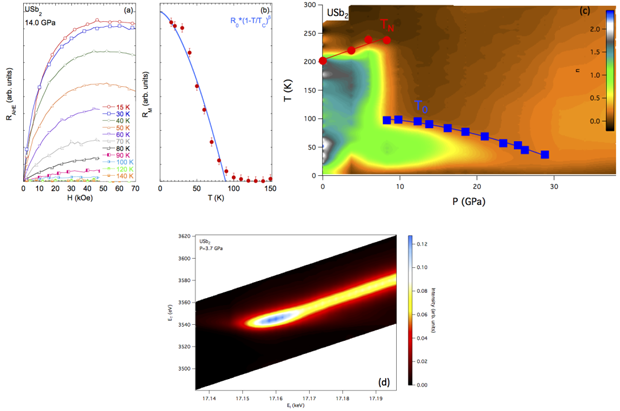Jason Jeffries (14-ERD-041)
Abstract
Quantum materials occupy a position at the leading edge of research in condensed-matter physics and offer tantalizing prospects for next-generation applications owing to exotic phenomena like unconventional high-temperature superconductivity, charge and density modulations, and topologically protected surface states. Harnessing these technological advantages is hampered by an incomplete understanding of their genesis, which ultimately arises from multiple quantum mechanical effects of the spin and orbit interaction and strong electronic correlations. These quantum mechanical perturbations can affect applications ranging from permanent magnets to nuclear fuel forms to quantum computing, and they can drastically alter the formation energies and phase stability of actinide alloys. We plan an experimental program combining sample synthesis and characterization, as well as high-pressure and chemical tuning. This research focuses on select 4f-shell and 5f-shell electron systems where the electronic structure manifests topologically protected surface states, valence-induced emergent magnetism, and magneto-structural volume collapse. The measurements we perform will provide valuable benchmarks of the structure–property relationships in actinide systems, which can be simulated using state-of-the-art theories under development at LLNL.
We plan to synthesize, characterize, and tune a series of interesting f-electron materials to examine the roles of spin–orbit coupling and strong electronic correlations on the electronic, structural, and magnetic degrees of freedom. Particularly, we aim to examine topological surface states, emergent magnetism, and magneto-elastic volume collapse. We expect to reveal the first experimental evidence for conducting, topological surface states in an actinide compound; illuminate the origin of emergent magnetism in a rare earth Kondo insulator (a material with strongly correlated electrons and temperature-dependent resistivity); and discover the role that f-electron hybridization plays in magnetically driven volume-collapse transformations. We will begin our studies by synthesizing single crystals using a molten metal flux technique, which permits the growth of crystals at a much lower and accessible temperature. Crystal quality will be assessed using conventional x-ray diffraction as well as electrical transport measurement.
Mission Relevance
Results of a successful research project will readily translate into benchmarks for predictive capabilities in actinide systems in support of LLNL's core competency in advanced materials and manufacturing, with ramifications for stockpile stewardship and weapons program activities in support of the central Laboratory mission in national security.
FY15 Accomplishments and Results
During FY15 we (1) successfully synthesized several samples and characterized them under pressure, including the rare earth metalloids CeB4 and PrB4, and performed high-pressure x-ray diffraction to investigate the possibility that PrB4 undergoes a valence change near 100 GPa; (2) synthesized a member of a strong spin–orbit coupled adaptive series of bismuth–tellurium and dibismuth telluride compounds (dibismuth telluride, Bi2Te, is a layered compound that exhibits semimetallic behavior at ambient conditions, but under pressure the system metallizes and shows superconductivity near 9 K); and (3) synthesized two actinide compounds, UPd2Si2 and USb2. The former has been interrogated using neutron scattering at the National Institute of Standards and Technology's Center for Neutron Research in Gaithersburg, Maryland, and the latter is undergoing pressure-dependent magneto-transport experiments at LLNL (see figure).
Publications and Presentations
- Butch, N. P., et al., “Symmetry and correlations underlying hidden order in URu2Si2.” Phys. Rev. B. 91, 035128 (2015). LLNL-JRNL-654108. http://dx.doi.org/10.1103/PhysRevB.91.035128
- Jeffries, J., et al., “Persistent Fe moments in the normal-state collapsed-tetragonal phase of the pressure-induced superconductor Ca0.67Sr0.33Fe2As2.” Phys. Rev. B. 90, 144506 (2014). LLNL-JRNL-645206. http://dx.doi.org/10.1103/PhysRevB.90.144506
- Jeffries, J., et al., “Pressure evolution of electrical transport in the 3D topological insulator (Bi,Sb)2(Se,Te)3.” J. Phys. Conf. 592(1) (2015). LLNL-PROC-663727. http://dx.doi.org/10.1088/1742-6596/592/1/012124
- Nakajima, Y., et al., “High-temperature superconductivity stabilized by electron-hole interband coupling in collapsed tetragonal phase of KFe2As2 under high pressure.” Phys. Rev. B. 91, 060508(R) (2015). LLNL-JRNL-667980. http://dx.doi.org/10.1103/PhysRevB.91.060508






